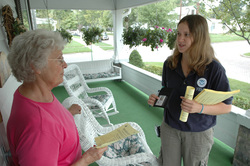|
|
|
|

|
 Thursday, August 24, 2017, marks
the sixth anniversary of the 2011 East Coast earthquake. While earthquakes may
be more prevalent in some areas than others, they can happen anywhere and are
unpredictable.
Taking steps ahead of time to
protect yourself in the event of an earthquake is vital in reducing injuries
and loss of life. The vast majority of injuries during an earthquake occur
because of flying glass and falling objects. Stay safe with these tips from Prepareathon’s
How to Prepare for an Earthquake guide:
- Prepare your home for an earthquake by securing
all items that could fall and cause injuries (e.g. bookshelves, mirrors, light
fixtures).
- Practice how to Drop, Cover, and Hold On under a
desk or table. Watch the When the Earth
Shakes video for more information on what to do if an earthquake happens
while you are inside, outside, or driving.
- Plan how you will communicate with family
members by making a family emergency
communication plan.
- When the shaking stops, look around. If there is
a clear path to safety, leave the building and go to an open space away from any
damage.
For
more tips on earthquake preparedness, visit www.ready.gov/earthquakes.
|
 With school bells ringing across
the Nation, it is time for parents and guardians to get familiar with the
emergency plan at your child’s school or daycare.
Much like individuals and
families, schools and daycare providers should all have site-specific emergency
plans. If you are a parent or guardian, it is important to make sure your
child’s school or daycare has a plan to ensure his or her safety during an
emergency.
The
Centers for Disease Control and Prevention (CDC) outline steps as easy
as ABC to keep your child safe at school or daycare:
-
Ask how you will reunite with your child
in an emergency or evacuation.
-
Bring extra medication, special foods, or
supplies that your child might need.
-
Complete a backpack
contact information card.
If your child has an access or
functional need, be sure to meet with a school official to discuss plans for
how the school will provide for his or her safety. For more information about
emergency preparedness for parents, educators, and kids, visit www.ready.gov/kids.
Parents, guardians, and teachers can also use
the Children and Youth
Preparedness Social Media Toolkit to share safety messages on their
social media networks.
|
 After a disaster, many community-based organizations come
together to support the needs of those affected. Unfortunately, individuals
with ulterior motives may also prey on those disaster survivors by offering
fraudulent services.
Learn how to protect yourself and your finances from
additional loss. The Federal Emergency Management Agency (FEMA) offers reminders
to help you avoid disaster fraud, including:
- Do not pay a fee to apply for FEMA
disaster assistance or to receive it. FEMA does not charge a fee for these
services.
- Get three written estimates for repair
work. Check credentials, and contact your local Better Business Bureau or
Chamber of Commerce to learn about any complaints against the contractor or
business.
- Make sure you obtain a written contract
detailing all necessary services and costs before work begins. The contract
should also have a projected completion date and outline ways to negotiate changes
and settle disputes.
- Pay only by check or a credit card. A
reasonable down payment may be required to buy materials for some projects, but
do not pay anything without a signed contract.
Be sure to check out
the full list of disaster
fraud tips and stay vigilant when disaster strikes. To register for FEMA
disaster assistance, call 1-800-621-3362 (TTY: 800-462-7585) or
visit www.DisasterAssistance.gov.
|
Disclaimer: The reader recognizes
that the federal government provides links and informational data on various
disaster preparedness resources and events and does not endorse any non-federal
events, entities, organizations, services, or products. Please let us know
about other events and services for individual and community preparedness that
could be included in future newsletters by contacting citizencorps@fema.dhs.gov.
|

|
|